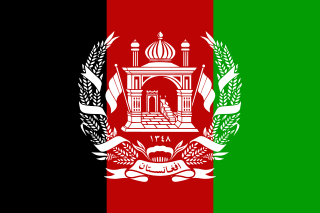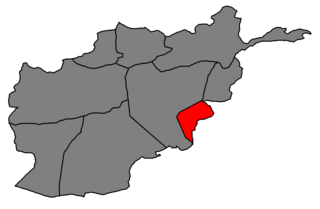Related Research Articles

Mohammad Daoud Khan, also romanized as Daud Khan or Dawood Khan, was an Afghan politician who served as prime minister of Afghanistan from 1953 to 1963 and, as leader of the 1973 Afghan coup d'état which overthrew the monarchy, served as the first president of Afghanistan from 1973 until his assassination in the Saur Revolution.

General Nawab Sir Sadiq Muhammad Khan V Abbasi was the 12th and final Nawab (ruler) of the state of Bahawalpur from February 1907 to October 1955, and then as a titular figure until his death in 1966.
Said Akbar Khan Babrakzai or Said Akbar Khan was an Afghan tribesman who assassinated the first Prime Minister and a leading founding father of Pakistan, Liaquat Ali Khan, at Company Bagh in Rawalpindi on 16 October 1951. Belonging to the Pashtun Babrakzai clan of Afghanistan, he fought against the Afghan government during the Tribal revolts.

The Kingdom of Afghanistan was a constitutional monarchy in Central Asia established in 1926 as a successor state to the Emirate of Afghanistan. It was proclaimed by its first king, Amanullah Khan, seven years after he acceded to the throne. The monarchy ended in the 1973 Afghan coup d'état.

The Khost rebellion, also known as the 1924 Mangal uprising, the Khost revolt or the Mangal Revolt was an uprising against the Westernization and modernizing reforms of Afghanistan’s king, Amanullah Khan. The uprising was launched in Southern Province, Afghanistan, and lasted from March 1924 to January 1925. It was fought by the Mangal Pashtun tribe, later joined by the Sulaiman Khel, Ali Khel, Jaji, Jadran and Ahmadzai tribes. After causing the death of over 14,000 Afghans, the revolt was finally quelled in January 1925.

The 1973 Afghan coup d'état, also called by Afghans as the Coup of 26 Saratan and self-proclaimed as the Revolution of 26 Saratan 1352, was led by Army General and prince Mohammad Daoud Khan against his cousin, King Mohammad Zahir Shah, on 17 July 1973, which resulted in the establishment of the Republic of Afghanistan under a one-party system led by Daoud Khan.

Mullah Mohammad Yaqoob Mujahid is an Afghan commander and cleric who is the second deputy leader of Afghanistan and the acting defense minister. He has been a deputy leader of the Taliban since 2016, and was additionally appointed to his ministerial role after the Taliban's victory over Western-backed forces in the 2001–2021 war. He has been the Taliban's military chief since 2020.
Jehandad Khan was an Afghan rebel emir who ruled only in Khost. He was born as a member of the Ghilzai tribe, and spent most of his life as a chieftain. After start of the Khost rebellion on 2 May 1912, he briefly laid claim to the Afghan throne in opposition to Habibullah Khan, but an offensive by Muhammad Nadir Khan forced him to flee to the British Raj by the end of the same month. When Jehandad arrived in India, he was given the option of immediately returning to Afghanistan or staying in India, and he chose the latter. He then appealed to the British authorities for an intervention in Afghanistan to aid the rebellion, but was unsuccessful. Later in 1912, Jehandad managed to return to Afghanistan, where he was apprehended, put on trial, sentenced to death and finally executed by a firing squad in 1914.

The Afghan tribal revolts of 1944–1947 or the Khost disturbances were a series of tribal revolts in the Kingdom of Afghanistan by Zadran, Safi and Mangal tribesmen which lasted from February 1944 to January 1947. The causes of the revolts laid in the worsening conditions of farmers, changes in conscription laws, the elimination of the power of Safi tribal leaders, Amanullah loyalism, trading monopolies, government surveillance, taxation, and poverty. The conflict began when government forces clashed with the forces of a tribal leader named Mazrak, who led the Zadran tribe in revolt. The Zadran uprising was followed by additional uprisings by the Safi and Mangal, the former of which elected their own king, Salemai. Faqir Ipi, a tribal leader from Waziristan, also fought for the restoration of former king Amanullah Khan alongside other rebels.

The Emirate of Afghanistan was an unrecognized state ruled by the Saqqawists that existed from January to October 1929. Habibullāh Kalakāni became the state's only emir on 18 January 1929. After the fall of Kalakāni on 13 October 1929, the Emirate ended.

Mazrak Khan Zadran was a Zadran chieftain who fought against the Afghan government during the Afghan tribal revolts of 1944–1947 in order to support the restoration of King Amanullah Khan. Some sources render his first name as Mazarak or Zemarak.

Amanullah loyalism was a series of early 20th century movements in the Kingdom of Afghanistan to restore Amanullah Khan as king of Afghanistan after he was deposed in January 1929 during the Afghan Civil War. Loyalists were sometimes referred to as Amanite. Loyalists tried to achieve this in various ways, including armed rebellions, political parties, colluding with foreign powers and assassinations. These movements petered out by the late 1940s. Amanullah died in exile in 1960 in Zürich, Switzerland, without ever regaining control, except a brief period of control in southern Afghanistan in the 1929 Afghan Civil War.
Shahswar was an Afghan politician who served as minister in under Salemai, who ruled only in the Eastern Province. Alternative renderings of his name include Shah Sarwar and Shasawar.
Amanul Mulk was an Afghan politician who served as the Minister of Defence under Salemai, who ruled only in the Eastern Province.

Babrak Khan was a Zadran chieftain who was the father of Said Akbar Babrak and of Mazrak Zadran.

Abdur Rahim Khan was an Afghan governor of Herat. He was born in 1886 in Kohistan. He served as the commander of Habibullah Khan's bodyguard from age 16. In 1921 he was promoted to brigadier. During the Afghan Civil War of 1928-1929 he joined the Saqqawists and was sent to Mazar-i-Sharif to organize a revolution. In September 1932 he was appointed by Mohammed Nadir Shah as governor of Herat. Also in 1932, he prevented a mutiny in Herat. He was appointed head of Perso-Afghan Boundary Commission in September 1934. In January 1946, he was arrested for suspected complicity with the Safi during the Afghan tribal revolts of 1944–1947, together with his son-in-law Khalilullah Khalili. He was released in 1948.
Amanat Lewana was an Afghan politician who served as prime minister under Salemai, a king of Afghanistan who ruled only in the Eastern Province.

Muhammad Umar Babrakzai is the tribal chief of the Zadran tribe and Afghan jurist.
References
- 1 2 3 4 5 6 Mason, Whit (2011-04-14). The Rule of Law in Afghanistan: Missing in Inaction. Cambridge University Press. pp. 85, 86. ISBN 978-1-139-49552-3.
- 1 2 Edwards, David B. (2017-05-09). Caravan of Martyrs: Sacrifice and Suicide Bombing in Afghanistan. Univ of California Press. p. 33. ISBN 978-0-520-29479-0.
- ↑ Olesen, Asta (1995). Islam and Politics in Afghanistan. Psychology Press. pp. 196, 198. ISBN 978-0-7007-0299-2.
- 1 2 Yapp, Malcolm; Preston, Paul; Patridge, Michael; Office, Great Britain Foreign (1999). British documents on foreign affairs: reports and papers from the Foreign Office confidential print. From 1946 through 1950. Near and Middle-East. University Publications of America. p. 178. ISBN 978-1-55655-765-1.
- ↑ Yapp, Malcolm (2001). British documents on foreign affairs: reports and papers from the foreign office confidential print. From 1946 through 1950. Near and Middle-East 1947. Afghanistan, Persia and Turkey, january 1947-december 1947. University Publications of America. p. 136. ISBN 978-1-55655-765-1.
- ↑ See Afghan tribal revolts of 1944–1947#Duration